Colors in the Dark

Those paintings of the soul that the Soviets failed to find are now in Jerusalem, where the backstory can finally be told
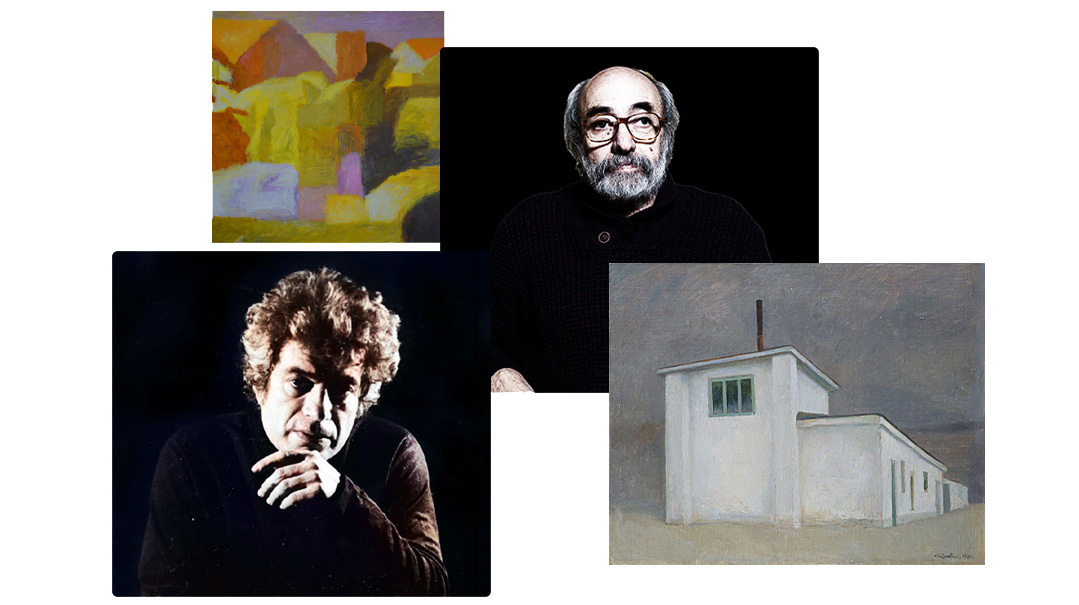
Photos: Elchanan Kotler
Behind the Iron Curtain, hidden away from the eyes of the KGB, two Jewish artists — each in a different city under different circumstances — sat and painted Jewish motifs with brushes, tears, and no little fear.
Years later, as their lives became joined through their children, those paintings of the soul that the Soviets failed to find are now in Jerusalem, where the backstory can finally be told.
Visitors walk through the exhibit, whispering to each other as they examine the paintings on the walls, studying the lines and colors as they try to decipher the hidden riddles the canvases hold.
But one person knows the secrets. “The fact that these paintings are being exhibited at all, and especially here in Jerusalem, is something that can’t be taken for granted, even nearly 30 years after my father’s death. My father nearly burned this entire collection. He was terrified of being discovered. And now, decades later, they’re finally seeing the light.”
His name is Rabbi Meir Ostrovsky, and he’s actually a big piece of the puzzle connecting this exhibit — now showing in Jerusalem’s Heichal Shlomo museum until the end of December — with the artists who created it. This is a joint exhibition of Rabbi Ostrovsky’s father, the late Yosef Ostrovsky, and his father-in-law, artist Michael Morgenstern. But the two mechutanim have more than a son and daughter in common — for they embody a modern history of Jewish art behind the Iron Curtain, where anyone creating Jewish themes or expressing a Jewish spirit could easily face Soviet imprisonment.
“People don’t realize what we went through in the Soviet Union. They don’t know that these paintings hanging here are literally a miracle,” says 67-year-old Michoel Morgenstern, sitting in a wheelchair (he suffers from a neurological condition) beside his son-in-law.
Because it’s a story that goes beyond art. It’s a testament to the possibility of returning to one’s heritage, of finding Hashem and connecting back to Yiddishkeit, and a revelation of the Hashgachah pratis that has accompanied them on their physical and spiritual journeys.
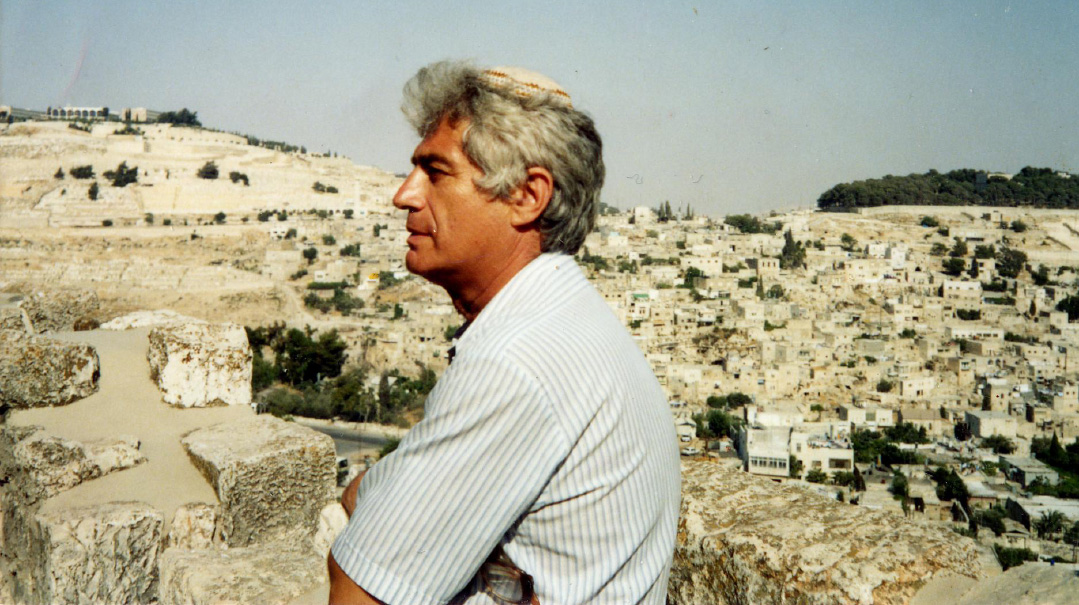
Yosef Ostrovsky a”h with his secret Jewish art, and after his aliyah. “Suddenly he was hit by a torrent of early childhood memories and he knew he had to get them on canvas”
Life Disappeared
Yosef Ostrovsky a”h was born in 1935 in the Ukrainian town of Shepetivka, once home to a thriving Jewish community and a center of chassidus (and the burial place of Rebbe Pinchas of Koritz). Yosef’s artistic talent was evident from the time he was big enough to hold a pencil.
“My father was very young when the war broke out and he really didn’t remember too much,” says Reb Meir. “By the time the dust settled, most vestiges of Yiddishkeit had disappeared.”
When he was 14, Ostrovsky applied to the State Art Academy in Odessa, which at the time was considered an artist’s haven. “It was a common joke that if you lived in Odessa and you weren’t a singer, author or artist, it wasn’t clear what you were doing there,” says Reb Meir. His father was younger than everyone else and had no professional experience, but he was soon accepted in the art community. It wasn’t long before he began to participate in large exhibits throughout the country, and although official state art was expected to be classical, robust, realistic and powerful, while “modern” and impressionist art was considered “western,” “degenerate,” and “anti-Soviet,” Ostrovsky managed to create his own style within the accepted parameters.
“My parents were not officially religious, but they had a strong connection to Jewish tradition,” Rabbi Ostrovsky says. “They settled in Odessa in the 1960s, which was a bit removed from the KGB periscope, so maybe there was a little more flexibility there. My sister was born then, and ten years later, I was born. We grew up in a warm home. We knew we were Jewish, and even knew a smattering of Yiddish. But the only one in the family who actually kept mitzvos was my grandmother — she kept Shabbos and didn’t eat meat. She told me that my grandfather Meir, whose name I carry, was a partisan who fought the Nazis. When I was 13, my family gave me his tefillin, so you could say we were connected. And just so that I wouldn’t forget, my peers in school made sure to remind me. We suffered daily from anti-Jewish attacks, both verbal and physical.
IN general, life was sailing smoothly for the Ostrovsky family, but then something unexpected happened. “At around the time my father reached his peak as an artist, he started having recurring dreams about his Jewish past and about the close relatives who had perished in the Holocaust,” Ostrovsky relates. “All at once, he was flooded by early childhood memories that came back to him in a torrent. He saw his grandfather putting on tefillin, his grandmother lighting Shabbos candles, and the town as it had been in his early years. He just couldn’t contain himself, and began to express his dreams and memories in paintings. So while he was producing famous works that were displayed at exhibits, he also drew a series of paintings of old Shepetivka, which had been wiped out in the war.”
The pictures catapult you into the pre-war Jewish village. At one point it’s the form of the artist’s grandfather, wrapped in a tallis; another time it’s a Yid who just came out of shul.
One can almost feel the soul of the artist hovering behind these images. “My father was able to do something remarkable,” Rabbi Ostrovsky says. “Through his paintings, he was able to revive the Jewish community of Shepetivka.”
Wasn’t it dangerous to paint Jewish-themed works at the time?
“Of course it was dangerous,” Rabbi Ostrovsky says. “We’re talking about the peak of the Communist era, when it was absolutely forbidden to express any message of faith or religion. But he just couldn’t help himself. It was as if another part of him took over. My father’s paintings were forbidden for another reason — they were more of an abstract genre. He knew that if his paintings would be discovered, we’d all be in trouble, so he hid them deep in his studio.
“We knew about the paintings, which my father called his ‘Jewish treasure.’ I even remember him painting some of them while he cried in anguish over what no longer was. My father knew there was a big chance his paintings would never be seen, but he painted them because they came from a place deep inside him that he couldn’t repress. At one point, the KGB was cracking down, and my father considered burning the entire collection in order to keep us safe. But the KGB got to him first.”
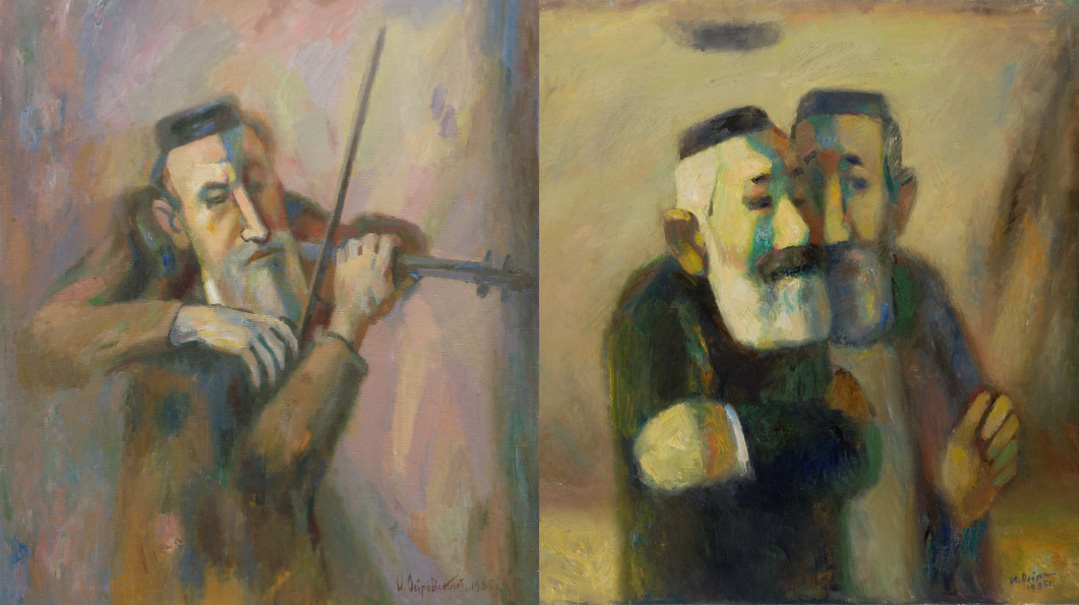
Secrets of the Dungeon
IN Communist Russia, all secrets were ultimately revealed — and Rabbi Ostrovsky remembers it well.
“I was about ten,” he recalls. “One day, my father was summoned for a meeting with the regional director of the KGB. It was around the same time that many Jewish artists and intellectuals were hauled in by the authorities. Some were exiled, others were incarcerated in insane asylums. The fear in our home was palpable. There was a knock on the door, and my father was escorted to KGB headquarters. We were all terrified as we waited anxiously for him to return, and only then did we learn that a tremendous miracle had occurred.
“My father told us how the director ushered him into his room and said, ‘We know everything about you, and also that you secretly create Jewish art. Now, you know that is a very severe transgression… but that’s not why I called you here.’ My father still could not calm down. He imagined that they wanted him to testify against his friends, which was how they extracted much of their information. But the director surprised him: ‘I was at an exhibit where your paintings were displayed, and since then, I’ve been following the ones you publicize. Now I’ll tell you a secret — I’m also an artist, it’s my hobby, and I’d like to hear your opinion about my paintings.’
“He took my shocked father and led him to the ‘disclosure’ cellar, a place where innumerable ‘enemies of the state’ had been tortured in order to extract information about their friends. Remarkably, it turned out that the walls were lined with paintings of flowers and butterflies, perhaps a way to soothe toughened souls into spilling the beans. My father gave him some professional tips, and of course, complimented him on his paintings. Then the director bid my father goodbye and released him.”
Ostrovsky remembers the celebration at home after that. “My father made a big, festive meal. We drank wine and thanked G-d for this miracle. After that, my father realized that if the KGB operative knew of his paintings and wasn’t going to prosecute him, he didn’t really need to hide anymore. So my father’s studio became a source of inspiration for many awakening Jews. Although it was underground activity, my father was no longer afraid to show his paintings to others.”
As the paintings came out in the open and his studio became a magnet for refuseniks — Jews who were reconnecting to tradition and who petitioned to make aliyah, Ostrovsky also experienced a spiritual awakening. He, too, began to dream of aliyah. Just a few years later, in 1989 with the fall of the Iron Curtain, that dream became a reality.
“At first my father received an offer to go to Miami to work at an art studio,” Reb Meir recalls. “But he turned it down. He said, ‘I’m a Jew, and Jews live only in Eretz Yisrael.’ And that’s how we all came to Israel.”
Reb Meir’s father-in-law, Michoel Morgenstern, although 20 years younger than Yosef Ostrovsky, was living a parallel life. He was born and raised in the capital city of Moscow and knew a bit about Yiddishkeit from his grandfather, who lived in “White Russia” (eastern Belarus) and who still davened with a tallis and tefillin every morning.
Morgenstern graduated from Moscow’s Academy of Arts in 1981, and was drawn to various art forms, including wall design, stained glass, murals and the like.
“In contrast to Yosef Ostrovsky, I hardly participated in exhibits,” he says. “Exhibits in those days were only for Socialist purists, and I connected to a totally different style. But like Yosef, I had a few Jewish friends and we’d get together for holidays and significant Jewish dates. There were times when the police came and broke up the gatherings, but we kept meeting. It was part of our opposition to the Soviet regime.”
Morgenstern says he attributes his family’s aliyah and return to tradition to his daughter, who became a baalas teshuvah on her own at the age of 11, drawing him and his wife into it. It was 1989; his daughter had become close to Rav Berel and Chani Lazar, who had recently arrived in Moscow. At the time, she decided that she wanted to take on a Jewish name, and she chose Esther. Rav Lazar conveyed the request to the Lubavitcher Rebbe, who gave a brachah, and then added in his own handwriting the name Emunah.
“We came to Israel in 1991 in the merit of Esther Emunah,” Morgenstern stresses. “First we lived in Jerusalem, and then we moved to the settlement of Psagot. Baruch Hashem, I’ve been able to earn a good living from my art, which I know is a bit unusual — most artists do this as a hobby.”
Over the years, Morgenstern has participated in many Israeli and international exhibitions, and his works can be found in art galleries and private collections in Israel, Russia, the US, Belgium, Canada, Germany, and Luxembourg. His works include murals, mosaics, and bas-reliefs in office buildings and restaurants around the country, and stained-glass windows in several community shuls.
While his paintings over the years, and especially in his Russian era, weren’t specifically Jewish in theme, many have an underlying Jewish narrative. “For example,” he says, “I have one called ‘Shivah,’ as if it were painted during the days of a shivah. There are also abstract paintings of Kiddush and other Jewish symbols. I like to paint from life, but I don’t paint scenes that look like photographs. No one can add anything to the Creation, but I feel that each painting is an extra dimension of illumination from Above. And there’s nothing for me as powerful as being able to share that light.”
Although Michoel Morgenstern is wheelchair-bound today and admits that every move is difficult, he’s still at it. Most of the paintings at this exhibit are from the past two years.
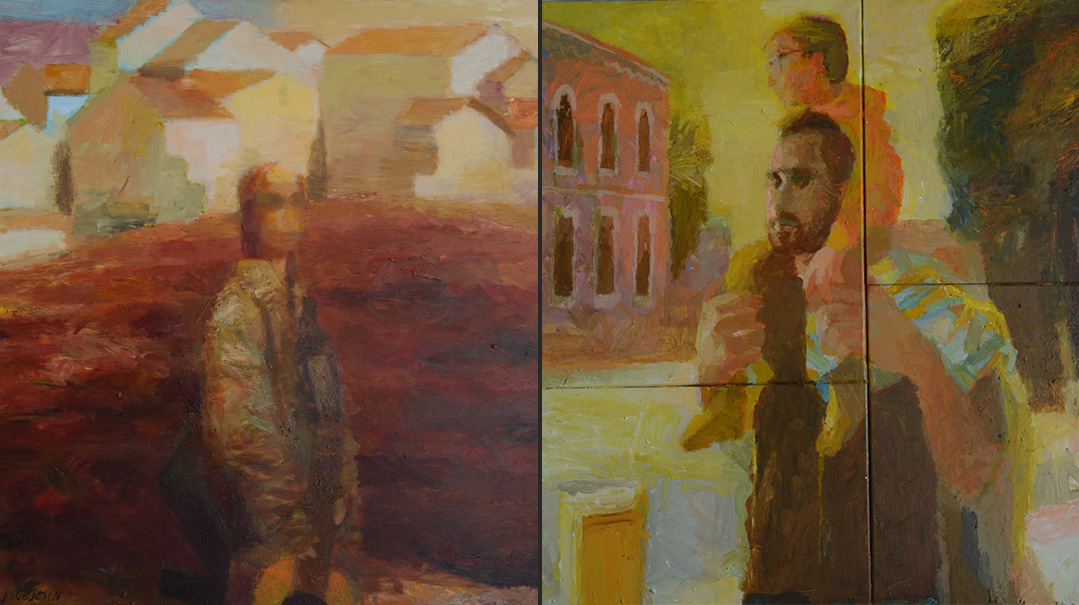
“I don’t paint scenes that look like photographs,” says Michoel Morgenstern. “No one can add anything to the Creation, but each painting is an extra dimension of illumination”
The Last Word
Meanwhile, soon after the Ostrovskys came to Israel, Yosef Ostrovsky fell ill, and the doctors didn’t give a hopeful prognosis.
“Even after he underwent surgery that improved his situation, the doctors estimated that he had between three and four years left,” says Reb Meir. “My father hoped that a miracle would happen, but he was aware of his situation. When he was offered to lead a project involving painting portraits of Israeli judges to adorn the walls of the High Court, he declined, explaining that his days were numbered. He didn’t want to start a project without knowing if he could finish it.
“From the time he learned that his clock was ticking, he utilized every minute of his life. He invested a lot in his art, but even more than that, into his family life. I remember that in January of 1991, he was invited to attend a major event in London where he was supposed to sell his paintings. But two days later, the Gulf War broke out. My father didn’t think twice — he left the exhibit and all the acclaim, and returned to Israel to sit with us in our sealed room.”
The Ostrovskys first lived in Ramat Gan and then moved to Sderot, where Yosef Ostrovsky is buried. “My father participated in an exhibit at Binyanei Ha’umah, where he met the mayor of Sderot, David Bouskilla. Bouskilla was intrigued by my father’s paintings and invited him to come live in Sderot. He promised my father that he would become the ‘city’s chief artist,’ and that he would organize courses and students for my father.
“But my father was very direct and honest. He asked the mayor: ‘Sderot needs an artist for just eight months?’ He then explained that it was the amount of time the doctors were giving him. The mayor almost cried, and said to my father, ‘Come with us, we want you no matter for how long.’ So my parents moved to Sderot. The mayor gave my father a huge 300-square meter studio and classes to teach. My father established a whole network of art courses, and people came from the entire south. The mayor also arranged a job for my mother in the local library.
“From the time we came to Israel, my father invested a lot in learning Hebrew. He would often joke, ‘It’s such a shame for me to die now, after I’ve become so fluent in Ivrit.’”
Rabbi Ostrovsky says his father’s last will was what changed his own life around.
“I was a student at Machon Lev, wearing a small ‘bottlecap’ kippah on and off. When I realized that my father’s condition was deteriorating, I left everything and came to be with him. On the day he passed away, he asked us all to come to him because he wanted to ‘give us an important message.’ I thought he’d tell us what he wanted us to do with his paintings, but Abba said something else: ‘It’s all nonsense — there’s only one thing — HaKadosh Baruch Hu, the Hayah, Hoveh veYihiyeh.’ It was Erev Yom Kippur, and my father’s words made an indescribable impression on me.” He pauses for a moment and then adds: “My situation today — a chassidic Jew, father of eight children and grandfather to four — is all because of him.”
While you might think that the Ostrovsky and Morgenstern families knew each other due to their similar backgrounds, they didn’t even make the connection until Esther Emunah and Meir were engaged.
“After my father’s passing, I became much more serious about my Yiddishkeit,” Reb Meir says. “I would come to visit my married sister, who happened to live next door to the Morgensterns. The shidduch was suggested, and that’s when I learned of my wife’s remarkable story. She was more advanced than I was in Yiddishkeit, and in her merit, I also grew stronger.”
Once Reb Meir visited her home and got to know her family, Morgenstern realized he was the son of Yosef Ostrovsky. “I was so excited,” he relates. “I told Meir that I knew his father from back in the Soviet Union. He was extremely well-known. And in fact, when we made aliyah, we even had a joint exhibit in Binyanei Ha’umah. Our paintings were hung side by side.”
Reb Meir enrolled in a Chabad yeshivah, jumping in with intensity as he turned his life around. Eventually he and his wife were sent as shluchim back to Ukraine, where he served as executive director of the Ohr Avner schools in Dnepropetrovsk. A few years ago, the family returned to Israel, from where he continued his work long-distance.
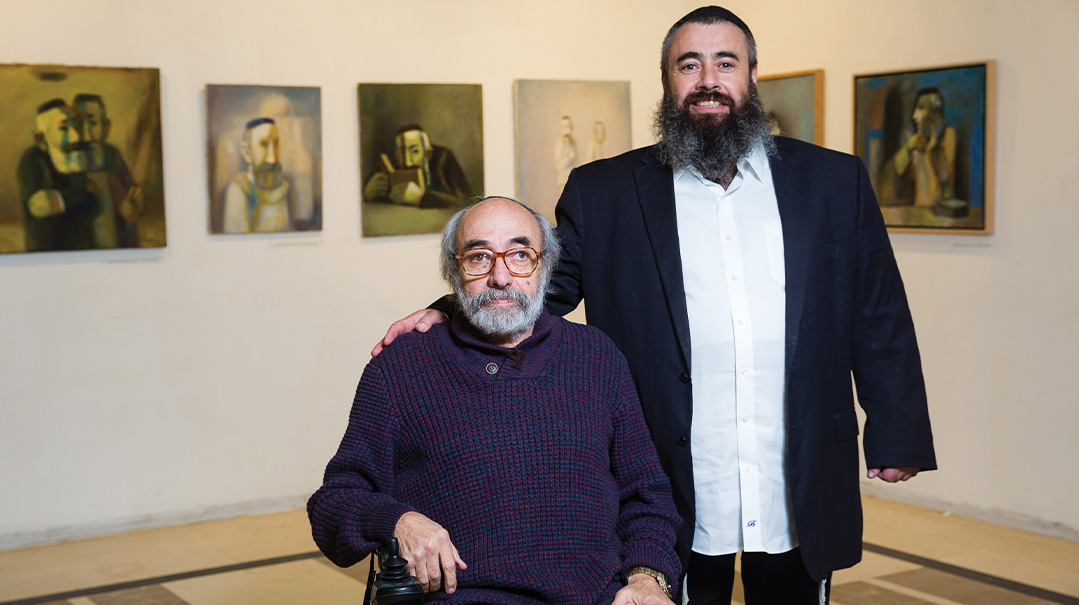
Michoel Morgenstern with his son-in-law Rabbi Meir Ostrovsky. Two mechutanim whose paintings were their own miracle of survival
Bird of Hope
The paintings at this exhibit are for sale — and they’re not cheap. Morgenstern’s paintings range between $3,000 and $4,000, and Ostrovsky’s are going from between $10,000 and $12,000.
“From experience I can say that there is no connection between the quality of the painting and its value,” Morgenstern clarifies. “I know very notable artists who cannot sell their works even at low prices. It’s all from Shamayim.”
Is there a painting they’re especially connected to?
Rabbi Ostrovsky’s father has been gone for nearly three decades — and maybe that makes the paintings even more special for him. “Each one is a world unto itself,” he says. “But still, I can tell you about one painting — called the ‘bird painting’ — that I’m very connected to. It was in the early 1990s, soon after we came to Israel. My father was not having a successful day. He had been insulted and hurt by someone and came home feeling very bad. In order to vent his troubles, he stood at the easel, and within a few hours, he’d completed the painting. It was the image of a bird falling.
“At four in the morning, I awoke to a noise, and I discovered a bird, identical to the one in the painting, flying around near my father’s painting. My father had also woken up. He came out of his room, his hands still stained with paint, looked at the bird for a moment, and then opened the window wide and said to the bird, ‘Fly away, we’ll still fly together.’ Then he told me how he wasn’t angry anymore and that he bore no grudge, because somehow he’d managed to channel all his harsh feelings into the painting.”
Michoel Morgenstern gives his own brave answer: “When people ask me which of my paintings I like best, I tell them it’s my next painting — the one I haven’t done yet,” Morgenstern says. “I already know my earlier ones, and the future one generates a level of curiosity and already makes me connect to it.”
And maybe that excitement and hope about the future helps explain one of the most moving moments between father-in-law and son-in-law.
“About two years after we got married,” Reb Meir shares, “when we had a one-year-old baby, my in-laws, who had married in the Soviet Union, decided that they wanted to have a proper halachic kiddushin, k’das Moshe v’Yisrael. They were becoming stronger in Yiddishkeit and knew they were lacking something basic — they wanted to complete their marriage. And they did — in a big, festive event in the Mercaz Gutnick yeshivah on David Yellin Street in Jerusalem. I merited to dance at my father-in-law’s wedding. It was a bit of an upside-down feeling, but we knew the Shechinah was right there.”
“My wife and I proved that it’s never too late,” Morgenstern adds. “Believe me, I have that image in my mind to this day. It’s the nicest picture I was ever zocheh to create.”
(Originally featured in Mishpacha, Issue 938)
Oops! We could not locate your form.







